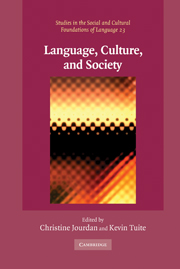Book contents
- Frontmatter
- Contents
- List of tables
- List of contributors
- Acknowledgments
- Introduction: Walking through walls
- 1 An issue about language
- 2 Linguistic relativities
- 3 Benjamin Lee Whorf and the Boasian foundations of contemporary ethnolinguistics
- 4 Cognitive anthropology
- 5 Methodological issues in cross-language color naming
- 6 Pidgins and creoles genesis: an anthropological offering
- 7 Bilingualism
- 8 The impact of language socialization on grammatical development
- 9 Intimate grammars: anthropological and psychoanalytic accounts of language, gender, and desire
- 10 Maximizing ethnopoetics: fine-tuning anthropological experience
- 11 Interpreting language variation and change
- References
- Index
- STUDIES IN THE SOCIAL AND CULTURAL FOUNDATIONS OF LANGUAGE
8 - The impact of language socialization on grammatical development
Published online by Cambridge University Press: 16 November 2009
- Frontmatter
- Contents
- List of tables
- List of contributors
- Acknowledgments
- Introduction: Walking through walls
- 1 An issue about language
- 2 Linguistic relativities
- 3 Benjamin Lee Whorf and the Boasian foundations of contemporary ethnolinguistics
- 4 Cognitive anthropology
- 5 Methodological issues in cross-language color naming
- 6 Pidgins and creoles genesis: an anthropological offering
- 7 Bilingualism
- 8 The impact of language socialization on grammatical development
- 9 Intimate grammars: anthropological and psychoanalytic accounts of language, gender, and desire
- 10 Maximizing ethnopoetics: fine-tuning anthropological experience
- 11 Interpreting language variation and change
- References
- Index
- STUDIES IN THE SOCIAL AND CULTURAL FOUNDATIONS OF LANGUAGE
Summary
An offer
The architecture of grammatical development in the talk of young children is the central concern of language acquisition research. The critical task of language acquisition scholarship over the last several decades has been to account for when, how, and why children use and understand grammatical forms over the course of the early period of their lives. Language socialization – the process in which children are socialized both through language and to use language within a community (Ochs and Schieffelin 1984; Schieffelin and Ochs 1986a, b) – has been largely examined without regard to the dynamics of grammatical development, focusing, rather, on culturally relevant communicative practices and activities. In this discussion, we reverse this orientation and focus directly on the role of language socialization in the acquisition of grammatical competence.
What can a language socialization perspective offer to scholarship on grammatical development? A language socialization perspective yields a more sophisticated model of grammatical development, that is, one tuned into certain cultural realities that influence when, how, and why young children use and understand grammatical forms. Such a model of grammatical development takes an informed look at ideology and social order as forces that organize children's use and comprehension of grammatical forms. A language socialization enriched model decries reductionistic visions that view the sociocultural context as “input” to be quantified and correlated with children's grammatical patterns.
- Type
- Chapter
- Information
- Language, Culture, and SocietyKey Topics in Linguistic Anthropology, pp. 168 - 189Publisher: Cambridge University PressPrint publication year: 2006
- 5
- Cited by

